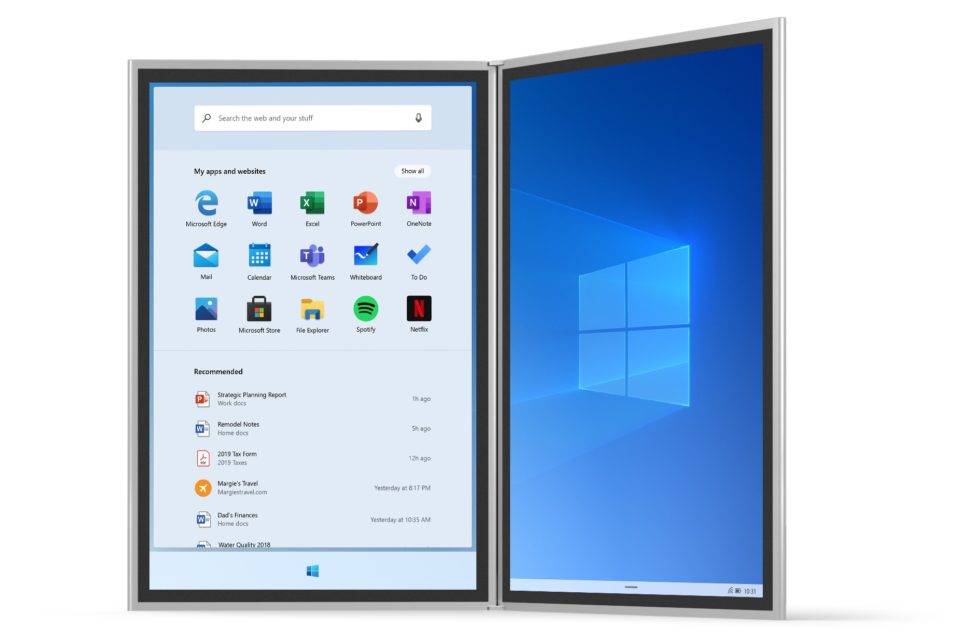
The code of the Windows 10X operating system is planned to be completed in early 2020, and the commercial launch will take place in the fall
Microsoft continues to keep secret the details of Windows 10X - a version of Windows 10 adapted for laptops and tablets with two screens. But now the first major leak gives a general understanding of the design and development goals of this OS, where native Windows 10 applications and web applications (PWA) will work on equal terms.
Screenshots and a description are published on the site santorini-os.azurewebsites.net . The link was first noticed by the user WalkingCat aka @ h0x0d . Information from the site has already been deleted, but another user, Boris aka @_milincic_, has saved an archive with screenshots of the pages .
Judging by the footer, the site was launched by the Santorini Design working group from Microsoft.

The documentation mentions lead designer Regina Son. A LinkedIn profile states that she’s been working on Windows and next-generation devices since July 2019.

The basic principles of the design of the Windows 10X interface: usability, efficiency and simplicity. UI architects say the design is based on research, testing, and technical documentation.
The operating system should basically provide maximum convenience, while not limiting the user. An example of this is the Quick Settings menu with a list of commonly used settings.
New Start Menu (Launcher)
The Start menu has been renamed to Launcher. It includes a line for searching the web (plus searching for documents and applications on a computer with voice input support), a static area of applications and web pages, as well as a list of recommended documents. Here is how it looks.

Santorini launcher
“Launcher helps users quickly start and resume tasks,” the documentation said. - Search easily integrates with web results, available applications and specific files on your device. Next in the content hierarchy is the default application grid, which you can customize and change to suit your individual needs and preferences. Launcher opens and further helps to accelerate the actions of the user, which over time pass into muscle memory. And finally, recommended content is dynamically updated based on the most frequently and recently used applications, files, and websites. You can return to your personal workflow without starting it from scratch. ”
Default Applications: Edge, Mail, Calendar, Word, Excel, PowerPoint, OneNote, Teams, Whiteboard, To Do, Photos, Store, File Explorer, Spotify, Netflix, Camera, Solitaire, Calculator, Alarms & Clock, Movies & TV, Office, Sticky Notes, Paint, Learning Hub, Settings, Weather, Snip & Sketch, Voice Recorder, Groove Music, People, Notepad, Feedback Hub, Media Plan, Messaging, and up to four OEM applications.
The grid of documents opens down. The icons from there can be dragged to the top so that they immediately appear on the first screen.
In this menu, you can group applications into folders and delete them from the grid (and from the device).
Lock screen
The lock screen is essentially absent, and the user can quickly authenticate as soon as the device is turned on (Restrained Lock model). This differs from the Windows 10 model, where before authentication you need to remove the “preliminary” lock screen (“curtain”) from the screen.

The screen for authorization in the system as of September 2019

The authorization screen in the system gives access to the desktop, the lock screen is essentially absent
Windows Hello face recognition is supported, as well as the Windows Hello PIN. After waking up from sleep mode, Windows Hello Face instantly recognizes the user and immediately opens his desktop.
Quick Settings Window
There are two levels in the settings section: the first shows up to ten of the most popular settings, and the second shows the rest. The first list to edit. Default Values:
- Wi-fi
- Cell Data (apparently cellular network data).
- Input language
- Compose Mode
- Bluetooth
- Flight mode.
- Screen rotation.
- Project
Task bar

Access to frequently used applications and sites, as well as task switching. Active tabs can be in the foreground or in the background. Grouping is supported when multiple instances of the application are grouped under the same icon. When hovering, Ul appears with thumbnails for various instances of this application. The taskbar displays the statuses “active state” (application in focus) and “execution state” (the icon is underlined when the application is running, regardless of whether it is in focus or not).
Designers say that they continue to experiment with a different grouping of icons (centered or left-aligned), with the number and size of elements, the number of recent events displayed, the presence / absence of a separator, and so on.
You can’t say for sure that this concept has already been adopted and approved by management. But in any case, we can conclude by what terms of reference the designers worked, that is, in what direction Microsoft wants to develop the UI of the operating system.
Windows 10X
Microsoft first mentioned the development of a new operating system in early October as the “OS for Surface Neo Dual-Screen Devices,” and announced a tentative release date for 2020.
The OS will probably appear simultaneously with these devices themselves. It seems that “Windows 10 Lite” can be installed on other devices, including laptops.
Insiders at Microsoft are reporting that the Windows 10X code is scheduled to end in early 2020, along with Windows 10 20H1, and Surface Neo and other devices with a new operating system will enter the market in the fall, before the start of the Christmas season.
Microsoft has not yet officially commented on the documentation leak.